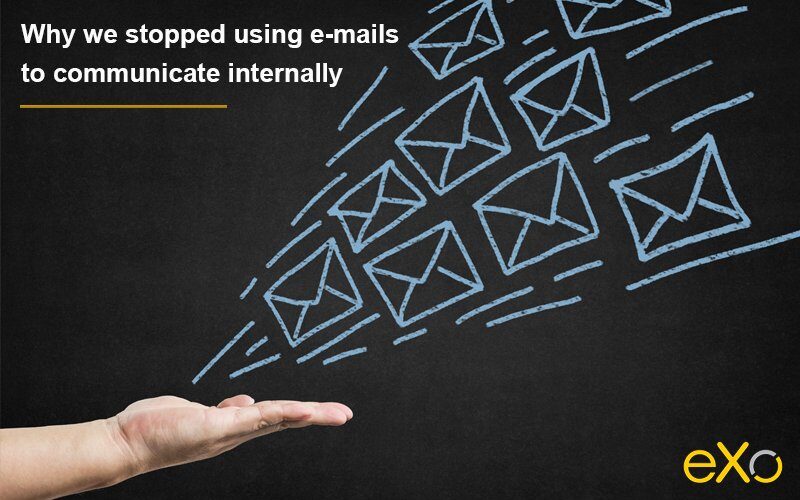- Brahim Jaouane
- January 16, 2020
Why we stopped using emails to communicate internally (and why you should too)
Improving internal communication and collaboration within the workplace is a top priority for businesses. A number of enterprise software solutions have been developed over the years to achieve these goals, from fax machines and email, to digital workplace solutions and productivity tools. Of all these great advancements, one solution has stood the test of time and is still widely adopted by businesses. We are talking about email.

Content
In this blog post, we will go through the top reasons that made us stop using emails to communicate and collaborate internally and the best alternatives to streamline communication and achieve higher engagement rates.
1. Too many e-mails… too little productivity
As mentioned earlier, the amount of email we send and receive every day is steadily growing year on year. This will make your inbox packed with emails ranging from important ones coming from colleagues or clients to regular newsletters and blog subscriptions. Needless to say, it is virtually impossible (and unnecessary) to go through all of them but when we do read even a small fraction, the time we spend on email can really add up. According to the McKinsey Global Institute, the average worker spends 13 hours per week reading and responding to emails. This translates to 28% of work time and 650 hours a year spent on unproductive tasks. Furthermore, it has been proven that emails are distracting, with employees taking up to 23 minutes on average to refocus on more important tasks.
These figures show the significant impact that emails have on our workday and overall productivity. This is why more and more businesses have been leaning towards more effective solutions to streamline communication and facilitate collaboration. One solution may be a team chat application like Microsoft Teams or Skype, or a holistic digital workplace with a built-in chat application.
2. Information loss
Emails are often associated with unread, lost and deleted information. This is due to the overwhelming number of emails we all receive and their structure, which often makes it tricky to find what we are looking for. This obviously leads to more time spent going through endless emails to locate information and away from more important tasks. In fact, according to the International Data Corporation, a typical employee spends 2.5 hours, or approximately 30% of the work day locating information. This can eventually lead to a significant decrease in productivity and high costs.
3. Not ideal for instant conversations or group chats
It is true that with the introduction of mobile devices, we can instantly be notified when we receive an email through push notifications. However, that does not make e-mails the perfect tool to communicate instantly due to their formal structure and the user interface that is not built or designed to support such conversations.
Adding to that, emails are also not ideal to initiate group chats and collaborate on projects. Just imagine the amount of time it takes to target specific audiences in an email thread, the time to exclude members, the lost information along the way. In short it is a messy and complicated process.
Email services like Gmail and Outlook have enhanced targeting and search in their latest versions but instant messaging is not meant to be done by email and they clearly know that. There are apps for that. Whether on a standalone or built-in chat application, conversations are instant, information is shared with ease and the app can be integrated with other tools or platforms (knowledge management, task management, calendars and more).
4. An old fashioned tool to communicate your company culture
Providing your employees with the latest announcements, corporate news and upcoming events will ensure a more engaged and informed workforce and promote a culture of transparency. As a result, it is crucially important to choose the right platform to convey these different messages. More often than not, businesses use email to communicate with their employees. It can be a good way to target specific groups or the whole company provided they end up opening the emails, which they do to a certain degree. According to Newsweaver<, the average open rate of internal emails is 66% with a click-through rate of 10%. However, tailored solutions like a digital workplace or an enterprise social network are more suited for top-down as well as bottom-up communication and can lead to higher engagement.
With advanced content management capabilities, HR specialists and the C-suite will be able to easily create, edit, organise and publish different types of content in centralised spaces to more effectively reach employees. Furthermore, social features will allow employees to participate in discussions about certain topics and interact with a variety of content via likes, comments and shares.
Email is still widely regarded as one of the most important business tools out there to communicate and get things done but reality and the very nature of email tells us a different story. In terms of internal communication, emails don’t deliver desirable results compared to new technologies like chat applications and digital workplace solutions. Email can also act as a distraction and a source of frustration to employees leading to a decrease in productivity.
Where to go from here:
with eXo Platform
FAQ
what is an internal communities?
Internal communities are places where employees can find help and support when they experience difficulties. I personally experienced such a community first hand several times, when joining a company among other newcomers.
What are the benefits of internal communities?
Here is a list of business benefits of internal communities to maximize your talent development:
- Natural support system
- Information sharing
- Talent development
- Innovation
- Employee satisfaction
What is the difference between internal and external communication?
Here are some Key differences between internal and external communications:
- The audience
- The goal
- The frequency
- The flow
- The means
➝ Find out the Key differences between internal and external communications
What is internal communications?
Communication is said to be internal, when the exchange of information, facts, opinions, etc occurs within the organisation itself. In internal communication, messages can be exchanged via personal contact, telephone, e-mails, intranet, modern communication tools or digital workplaces.
It usually helps in developing plans for accomplishment, organising resources, training, appraising and motivating employees to put their best foot forward.
What is external communications?
External communication can be defined as sharing information between the company and any other person or entity from the external environment such as customers, suppliers, investors, clients, dealers, society, etc, as their opinions on the company and brand have a great impact on the business.

Related posts
- All
- eXo
- Digital workplace
- Employee engagement
- Open source
- Future of work
- Internal communication
- Collaboration
- News
- intranet
- workplace
- Knowledge management
- Employee experience
- Employee productivity
- onboarding
- Employee recognition
- Change management
- Cartoon
- Digital transformation
- Infographic
- Remote work
- Industry trends
- Product News
- Thought leadership
- Tips & Tricks
- Tutorial
- Uncategorized


